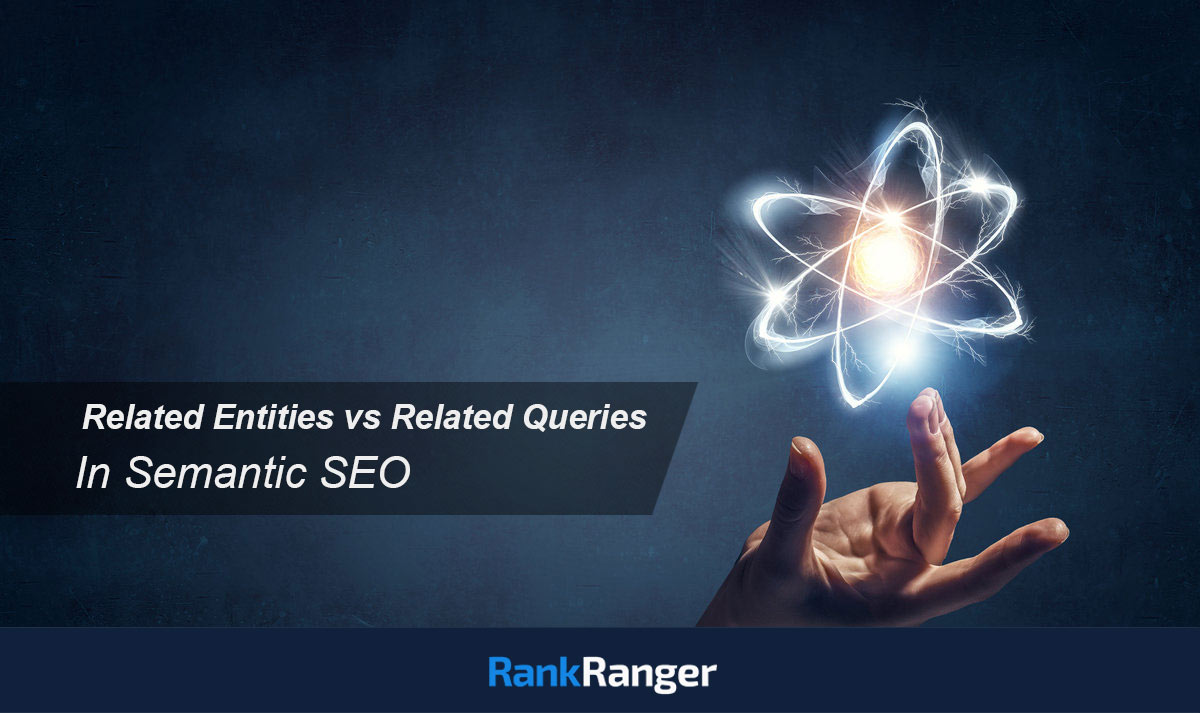
Posted by
Darrell Mordecai

Topical authority is a semantic SEO strategy that could bring massive traffic to your site.
To achieve topical authority, you must create authoritative content that covers an entire topic. However, to be successful it really pays to first understand what entities exist in Google’s Knowledge Graph and how they are structured.
In my previous post, I covered how to research entities in Google’s Knowledge Graph.
The point of this analysis is to give you the information to figure out not only what content assets to make but also how to create a structure that not only makes sense to your readers but also to Google.
I explained that you are looking for:
- Related Entities
- Related Topics
- Related Queries
In this post, I want to clarify the difference between related entities and related queries and why the difference makes a difference to how you do SEO.
Big Picture Overview
During your research process, you’ll come across related entities and related queries. Although they might look similar, their conceptual difference means they should be treated differently when creating your big-picture SEO strategy.
What are Related Queries?
Related queries can be found in Google’s Auto Suggest, People Also Ask, and Related Searches features.
Google uses these features to give the user options to explore the topic they have searched by presenting commonly asked questions related to the original search query. This means Google has connected these queries to the original query.
To truly appreciate how related queries are structured, look in the Rank Ranger Keyword Suggestions tool.
As you can see in the screenshot below, all the related queries are variations of our primary topic or entity.
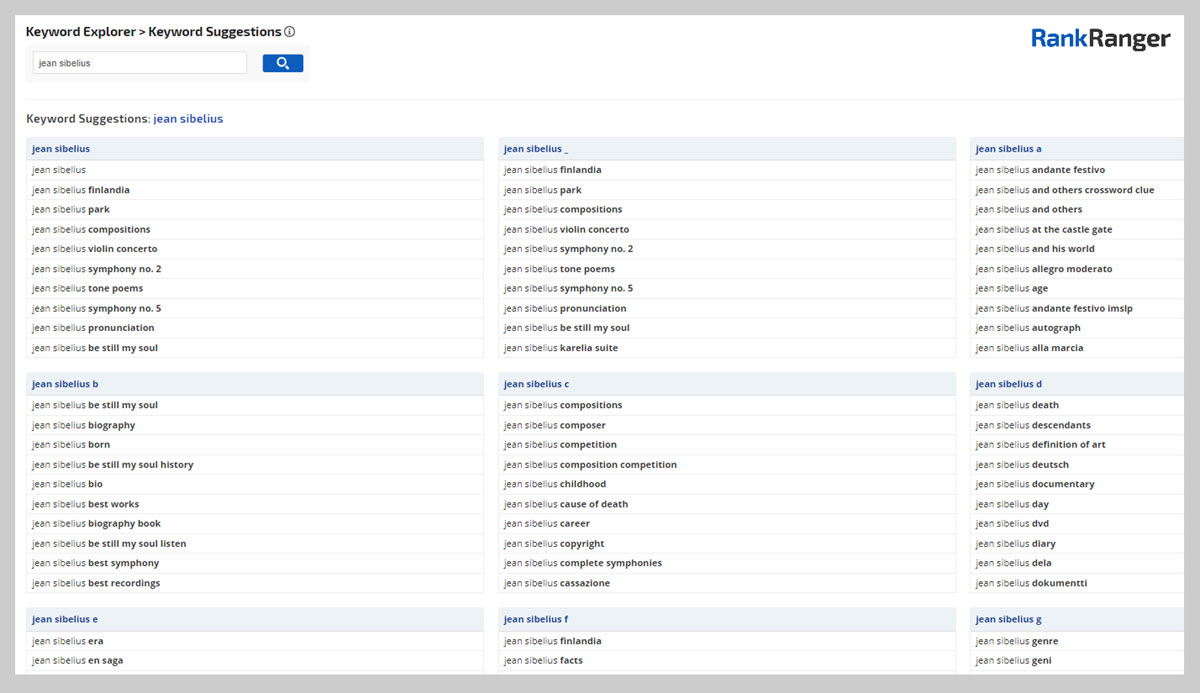
In other words, all of the terms above have the primary entity in them. The reason they are all different from each other is each one includes a modifier after the primary entity.
So, in the screenshot above, the primary entity is the Finnish composer Jean Sibelius. This means each query has the words ‘Jean Sibelius’ in them. The tool brings modifiers that are categorized alphabetically. [entity or keyword] + modifier
For example:
- Jean Sibelius tone poems
- Jean Sibelius compositions
- Jean Sibelius Finlandia
All of these terms represent queries that a Google user would type into their browser if they were requesting information about the entity Jean Sibelius.
Here, Rank Ranger has identified a long list of queries that are requesting different types of information about the same entity.
Another place to look for related queries is Google Search Console.
Now, it’s important to understand how related queries differ from related entities.
What are Related Entities?
Related entities on the other hand are not queries or keywords at all. You can’t simply find them by looking for keywords that include your main entity in a keyword research tool. The reason is related entities are not keywords at all. Instead, they are entities that Google sees as related to the main entity you are researching. In this case, the main entity is Jean Sibelius.
This means they are not as easy to find as related queries. I covered how to find them in my previous post which I linked to at the top of this post.
Related entities are entities that have a semantic relationship with your main entity.
To understand this point properly you must understand that Google doesn’t just include entities in its Knowledge Graph together with their definitions. Google also understands that entities in its Knowledge Graph relate to one another through having similar attributes.
This means, unlike related queries, related entities don’t necessarily include any mention of your entity. They are separate from your entity but are in a relationship with it.
Sounds ********. Allow me to explain.
So for instance, if you look at the Rank Ranger Related Keywords report for the entity Jean Sibelius, you might notice that the list of ‘Related Keywords’ doesn’t include the words Jean Sibelius in them.
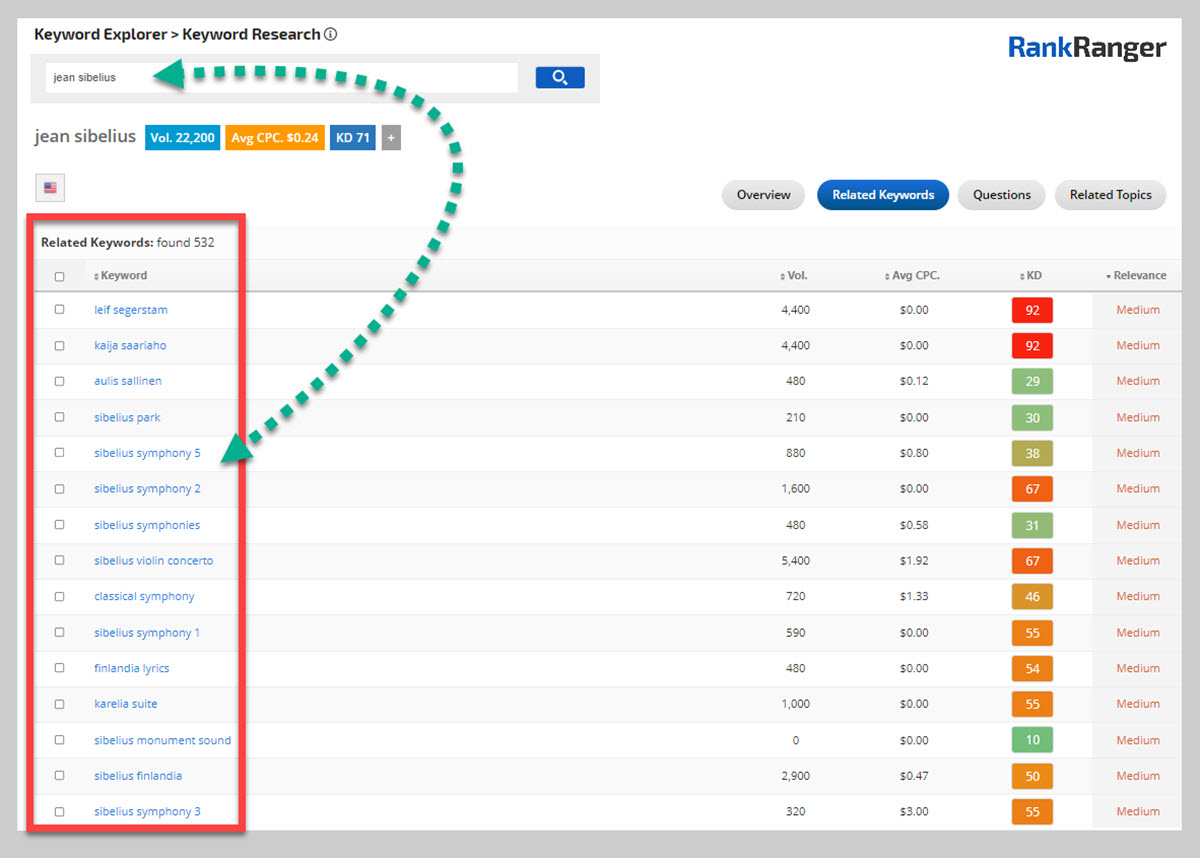
As you can see in the screenshot above, the tool is bringing a list of ‘keywords’ that are not just modified versions of the keyword Jean Sibelius. Instead, these terms are referring to things or people that have a conceptual relationship with Jean Sibelius.
Take the term ‘Maxim Vengerov’ for example. Jean Sibelius composed a violin concerto that was performed by the violin virtuoso Maxim Vengerov.
Now that you know that, you can easily see the conceptual relationship between the entity Jean Sibelius and the entity Maxim Vengerov. But that’s your human understanding.
How does Google treat this relationship between entities?
These two entities appear in Google’s Knowledge Graph linked together. They are linked to one another in a way that resembles how your mind comprehends their relationship. (I’m describing it this way because Google doesn’t actually understand anything.)
What’s more, I’m going to venture a guess as to how Google links these entities.
Firstly, Google ‘understands’ that Sibelius composed his violin concerto.
How on earth do I know that? Here is some evidence.
Try typing Jean Sibelius compositions into Google and take a look. You’ll see that Google presents tabs that link to Sibelius’s compositions. The first one is the violin concerto.
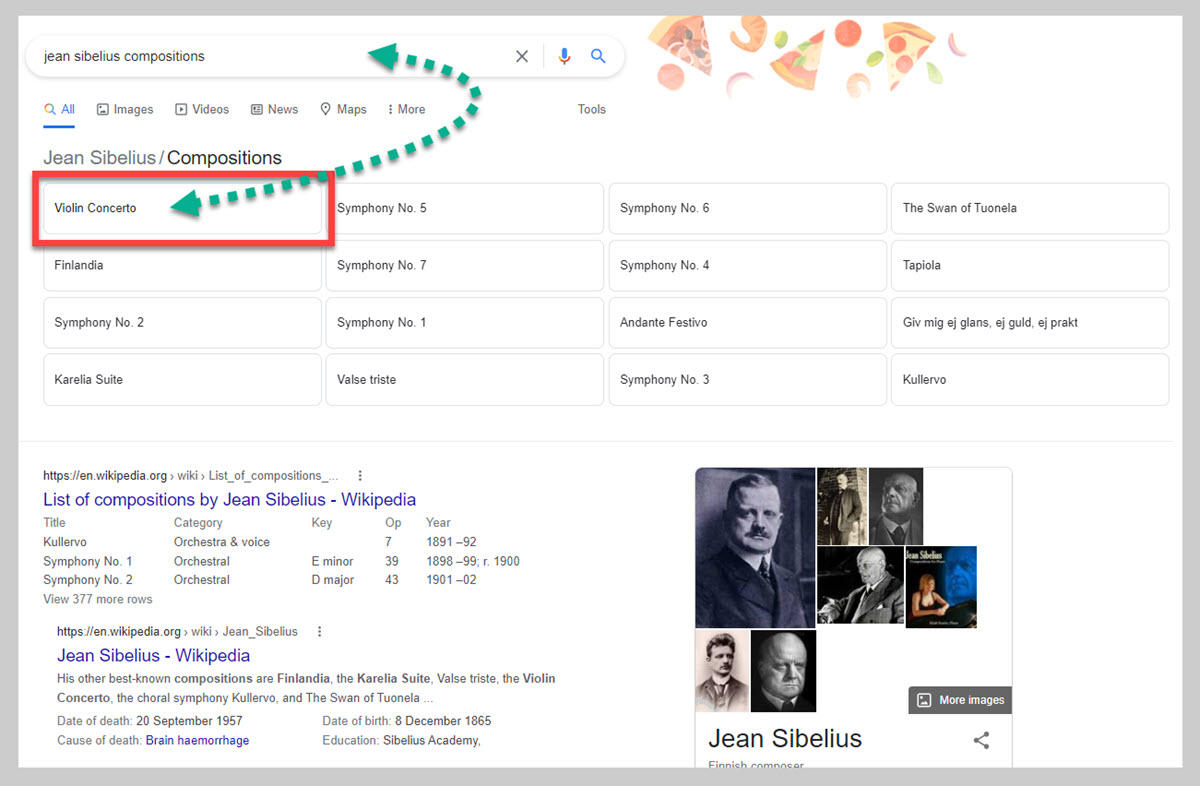
It’s clear from the first tab that Google ‘gets’ that Sibelius composed the violin concerto.
Now that we’ve established that, let’s see if we can connect Maxim Vengerov to Sibelius through the violin concerto.
When you click the violin concerto tab, the SERP results change to include videos of violinists performing the concerto. The second result is a video of Maxim Vengerov performing the concerto. (Yes, Maxim is playing second fiddle to the great Hilary Hahn. I know, don’t quit my day job. 😁)
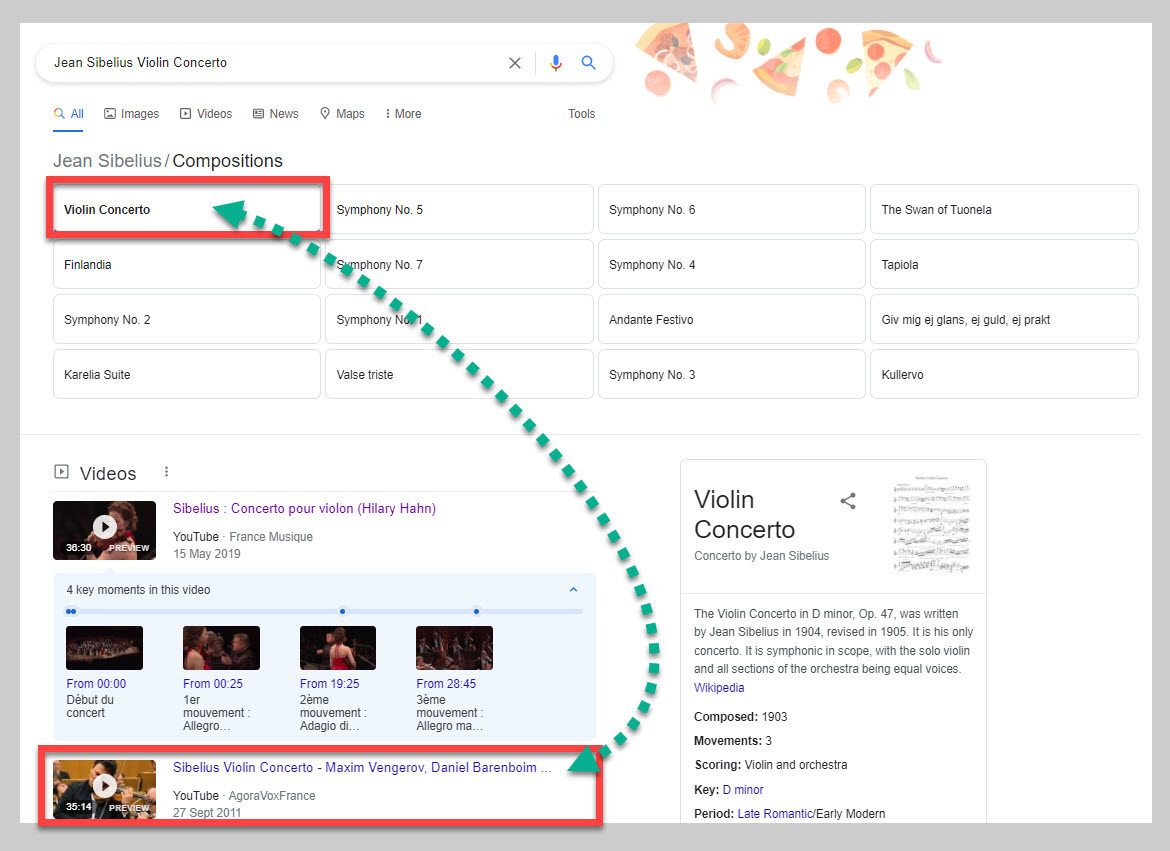
This means we have found a clear link between the Sibelius concerto and Maxim Vengerov. What’s more, we found the connection between them by looking at SERP features. To my knowledge, Google’s SERP features get their information from Google’s Knowledge Graph.
This means, in all likelihood, (from a layman’s perspective) the information in Google’s Knowledge Graph looks something like this:
Jean Sibelius composed a violin concerto that was performed by Maxim Vengerov.
This sentence is made up of two semantic relationships or triples:
- The entity [Jean Sibelius] composed the entity [Jean Sibelius violin concerto]
- The entity [Maxim Vengerov] performed the entity [Jean Sibelius violin concerto]

Although a step removed, the entity Maxim Vengerov is clearly connected to the entity Jean Sibelius.
This is what I mean by a related entity.
Okay, so you get the conceptual difference between related queries and related entities, but what does that mean to your SEO?
Improving Your Content Through Related Entities and Related Queries
To sum this all up, related queries refer to how a user interacts with Google by requesting content. These queries are user-related and Google will analyze these queries to know what information the user is requesting.
Google’s analysis will include:
- What entity the user is requesting information about
- What type of information is being requested (think what, where, and how type questions)
Based on this analysis, Google will look to the content in its index to answer the query.
And that’s where related entities come in. Google will look to content in its index to answer these who, what, why questions about the entity. So if someone were to type ‘who played sibelius violin concerto’, Google will get that it’s a ‘who’ question and will look for content that answers the question with the related entities. Specifically, entities that performed the Sibelius violin concerto.
Using Related Queries in Your Content
Since related queries represent queries that a Google user might type into their browser, using these queries in your content will signal to Google that your content is relevant.
What’s more, it’s a great idea to include these actual queries in your content because one of the goals of semantic SEO is to achieve topical authority by covering the entire topic thoroughly. This means you should aim to create structured top-down content as well as cover every single question a user might ask.
The reason this is so important is when Google includes these related queries in People Also Ask boxes, Google is presenting queries that are related to the original search term that might be helpful as a next step. This means Google clearly relates these queries to the primary entity and covering these ‘next step’ queries means your content will cover more aspects of the topic. Covering more aspects of a topic helps Google provide a stellar experience and user journey.
So, to sum this up, creating content that answers users’ queries will only strengthen your overall content and your authority on your chosen topic.
Using Related Entities in Your Content
To help you understand where related entities fit in, let me use an extreme example.
There are times when you write about an entity that could have more than one meaning. An obvious example is the term ‘apple’. In all likelihood, Google understands the term in two ways. It’s either a fruit, or it’s a technology company.
This is where Google’s entity relationships can really help you out.
If, for instance, you were writing about apple the fruit, including related entities such as nutrition, calories, green apple, apple pie, apple benefits, and other fruit-related entities, Google will easily know which entity your content is about.
This is all due to the fact that all of these entities are related to one another.
So using an example Kristine Schachinger used in an interview with Laurent Bourelly if you write about the Hulk, Wonder Woman, Captain America, Google will be able to figure out that you are talking about Marvel. What’s amazing is Google can figure it out even if your content doesn’t mention Marvel.
Google is able to do this because these entities are closely related to Marvel the entity.
Summing It All Up
By now you should have a solid understanding of the difference between related entities and related queries. You’ve also understood the strategic difference between them and how they relate to your overall SEO strategy.
This puts you in a great position to build a solid semantic SEO strategy.
Stay tuned as I’ll be delving into this topic further.




